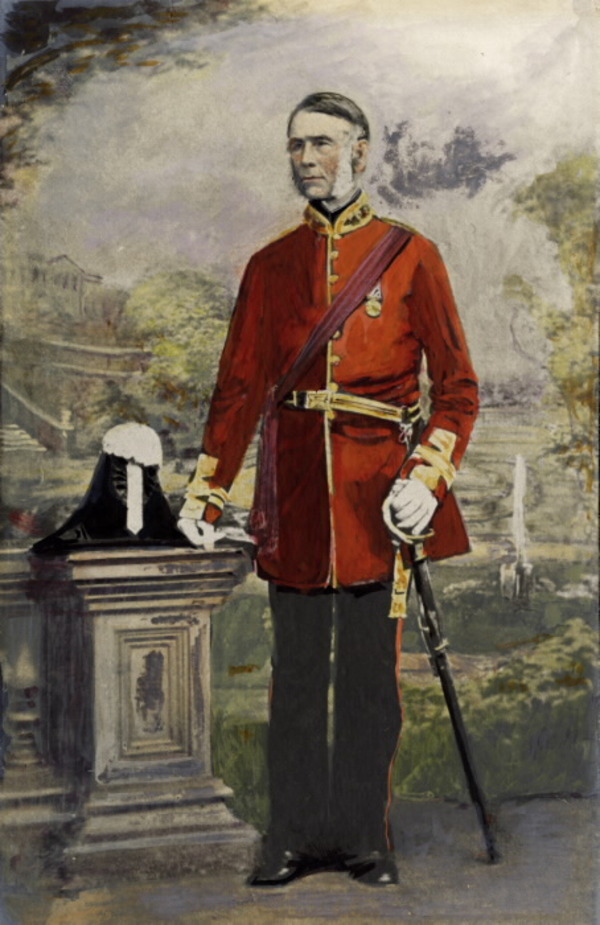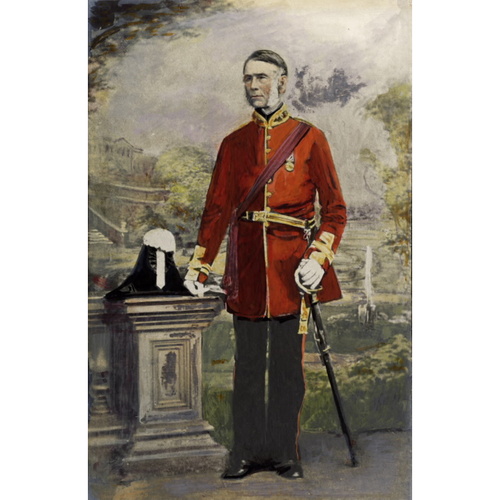THOMSON (Thompson), EDWARD WILLIAM, farmer, militia officer, and politician; b. January 1794 at Kingston, Upper Canada, son of loyalists Archibald Thomson, a carpenter, and Elizabeth McKay; d. 20 April 1865 in York Township, Canada West. Thomson married first in 1815 Sarah Maria Terry of Scarborough Township, by whom he had three sons and four daughters; secondly, in 1829 Mary (d. 1832), daughter of Jesse Ketchum, by whom he had two children; and thirdly, in 1834, Selina Lee, widow of Dr Archibald Chisholm, the first physician to practise in London, Upper Canada, by whom he had one daughter.
Edward William Thomson moved with his family to Newark (Niagara-on-the-Lake) in 1795, to York (Toronto) in 1796, and to Scarborough Township in 1808. During the War of 1812 he served in Captain Duncan Cameron*’s flank company of the 3rd Regiment of York militia. He was present at the capture of Detroit by Isaac Brock*, was decorated for valiant services at Queenston Heights, and received a militia land grant. He was among those paroled after the American capture of York in 1813. Thomson maintained his military connections over a long period. He was promoted captain in the 1st West York Regiment in 1822, and transferred to the 3rd West York militia in 1827. He served during the rebellion of 1837–38 and became lieutenant-colonel of the 7th Regiment of North York militia in 1839. He transferred to the 7th battalion of York militia in 1846, and in 1856 was named commander of the 5th Militia District of Canada West.
During the 1820s Thomson moved to the Johnstown District and became involved, in association with George Crawford, in the construction of locks on the St Lawrence and Rideau canals. In 1830 he moved from Maitland Rapids (Kilmarnock), Grenville County, to York. Two years later he transferred his contract to Crawford and moved to land in Toronto Township. He subsequently purchased and farmed a number of properties in the area which now forms part of Toronto. He was also a contractor on the Welland Canal, possibly in the 1840s when the wooden locks were replaced by larger stone structures. In 1847 the editor of the British American Cultivator described Thomson as a “native Canadian Farmer, who has passed through the various stages of hardships and trials, incident to a backwoodsman’s life and withal a self-educated man.”
Thomson was an elder in St Andrew’s Presbyterian Church, Toronto, and a conservative in politics. Defeated for the assembly by William Lyon Mackenzie in the 2nd Riding of the county of York in 1834, he was successful against him in 1836, a triumph probably more attributable to the election campaign of Sir Francis Bond Head* than to his own abilities as a politician. Charles Lindsey* claimed that Thomson tended to support the Family Compact in the assembly, but Sir Francis Hincks*’ Examiner praised him for voting on several occasions to appropriate the Clergy Reserves for educational purposes, and for opposing any measures leading to political monopoly or exclusiveness. He was unsuccessful in 1851 against Amos Wright* in York East, and in 1863 against William Pearce Howland* in York West.
Thomson made his greatest contribution in the field of agriculture, first as a founder in 1830 and president of the Home District Agricultural Society, and later as the first president of the Provincial Agricultural Association, established in 1846, and of the York County Agricultural Society, founded in 1850. Thomson advocated the improvement of farm stock and produce, and he imported and bred pure livestock on his own farm. He also supported the domestic manufacture of agricultural implements, and the establishment of a model farm and agricultural museum. He was a Canadian representative at the exhibitions of 1851 and 1862 in London.
Thomson was, at various times, a magistrate, warden of the Home District, a founder and trustee of Queen’s College at Kingston, and vice-president of the Upper Canada Bible Society. He was also president of the Farmers’ Mutual Fire Insurance Company, and a director of the Farmers’ Joint Stock Banking Company and of the Canada Landed Credit Company. He died on 20 April 1865 while walking to Toronto from his farm for a meeting of the council of the Provincial Agricultural Association.
London Public Library and Art Museum (London, Ont.), Edwin Seaborn coll MTCL, Humber Valley archives, E. W. Thomson file. PAC, RG 1, L3; RG 68, 1, General index, 1651–1841. PAO, Bull (William Perkins) coll.; “Data on United Empire Loyalists,” comp. W. E. Reid (typescript); RG 8, I-6-A, 8,100. “The Proudfoot papers,” ed. M. A. Garland, OH, XXVII (1931), 435–96. Canada Farmer; a Fortnightly Journal of Agriculture, Horticulture, and Rural Affairs (Toronto), 1 May 1865. Examiner (Toronto), 29 Dec. 1841. Globe, 21 April 1865. Journal of Education for U.C., XVIII (1865), 62. Illustrated historical atlas of the county of York . . . (Toronto, 1878; repr. 1969). W. P. Bull, From Brock to Currie, the military developments and exploits of Canadians in general and of the men of Peel in particular, 1791 to 1930 (Toronto, [1936]). Dent, Upper Canadian rebellion. Fourteen generations in North America, comp. J. H. R. Thomson (Calgary, [1967?]). A history of Upper Canada College, 1829–1892; with contributions by old Upper Canada College boys, lists of head-boys, exhibitioners, university scholars and medallists, and a roll of the school, comp. George Dickson and G. M. Adam (Toronto, 1893). Lindsey, Life and times of Mackenzie. Robertson’s landmarks of Toronto, II. Edwin Seaborn, The march of medicine in western Ontario (Toronto [1944]).
Cite This Article
Ann MacKenzie, “THOMSON (Thompson), EDWARD WILLIAM,” in Dictionary of Canadian Biography, vol. 9, University of Toronto/Université Laval, 2003–, accessed December 24, 2025, https://www.biographi.ca/en/bio/thomson_edward_william_9E.html.
The citation above shows the format for footnotes and endnotes according to the Chicago manual of style (16th edition). Information to be used in other citation formats:
| Permalink: | https://www.biographi.ca/en/bio/thomson_edward_william_9E.html |
| Author of Article: | Ann MacKenzie |
| Title of Article: | THOMSON (Thompson), EDWARD WILLIAM |
| Publication Name: | Dictionary of Canadian Biography, vol. 9 |
| Publisher: | University of Toronto/Université Laval |
| Year of publication: | 1976 |
| Year of revision: | 1976 |
| Access Date: | December 24, 2025 |




